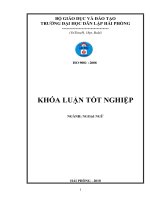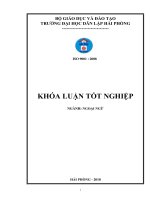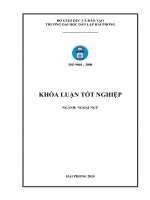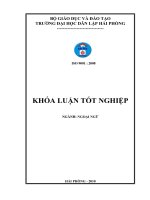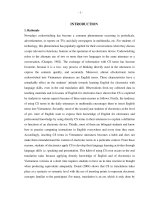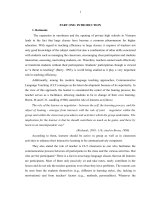A study on stress management techniques in a hospital
Bạn đang xem bản rút gọn của tài liệu. Xem và tải ngay bản đầy đủ của tài liệu tại đây (83 KB, 8 trang )
International Journal of Management (IJM)
Volume 7, Issue 7, November–December 2016, pp.418–425, Article ID: IJM_07_07_046
Available online at
/>Journal Impact Factor (2016): 8.1920 (Calculated by GISI) www.jifactor.com
ISSN Print: 0976-6502 and ISSN Online: 0976-6510
© IAEME Publication
A STUDY ON STRESS MANAGEMENT TECHNIQUES
IN A HOSPITAL
A. Saravanakumar
Research Scholar, GRD Academy of Management,
Bharathiar University, Coimbatore, India
Dr. S. Akilandeswari
Assistant Professor, Department of Business Administration,
Government Arts College, Coimbatore, India
ABSTRACT
A study on “Stress Management Techniques in a hospital” topic stated that level of stress from
managers in a hospital. The objectives of this study are (i.) To assess the stress management
techniques followed by the hospital and offer suggestions for reducing stress among the members.
(ii.) To assess the relationship between stress and experience, between stress and age of managers
in the hospital. The research design used for this study is descriptive research.
The population of this study is managers. Since the population is not huge, the whole
population of managers were considered as samples for the study which totaled to 120.In the
entire study population, it’s noted that 10% of the sample falls within the age range of 21-30, 50%
is in the age group of 31-40,27% of the sample lies in the age group of about 41-50 and the
percentage of sample that falls in the category 51 and above is 13%.The majority of the sample of
about 33% has total work experience of about 11-15 years.27% of the sample has an experience of
about 21 and above years.17% of the sample falls in the category of 0-5 years of total
experience.12% of the sample lies in the category of 16-20 years of experience. The sample that
has about 6-10 years of experience is 10%.
This study has shown that the managers are working in hospitals do feel stress but not in very
high levels.
Key words: Stress management, Managers, Age, Experience, Hospital
Cite this Article: A. Saravanakumar and Dr. S. Akilandeswari, A Study on Stress Management
Techniques in a Hospital. International Journal of Management, 7(7), 2016, pp. 418–425.
/>
1. INTRODUCTION
Human behavior in an organization is influenced by various physical, social, and psychological factors. An
important aspect of organization that integrates an individual into the organization is the role assigned to
him/her within the overall structure of the organization. Organizations are grappling with increasing
problems of stress in the workplace and initiating appropriate responses. A large number of employees
/>
418
A Study on Stress Management Techniques in a Hospital
experience unacceptable levels of stress. Stress is often termed as a twentieth century syndrome, born out
of man's race towards modern progress and its ensuing complexities. It has become the most important
factor influencing individual efficacy and satisfaction in modern day occupational settings.
Hans Selye first introduced the concept of stress in to the life science in 1936. He defined stress as "The
force, pressure, or strain exerted upon a material object or person which resist these forces and attempt to
maintain its original state." Stress is ubiquitous in our society. It has become an integral part of everyday
living. Stress is an unavoidable consequence of modern living. At one point or the other everybody suffers
from stress. It is a dreaded symptom of the 21st century corporate environment. With the growth of
industries, pressure in the urban areas, quantitative growth in population and various problems in day to
day life are some of the reasons for increase in stress.
Stress is a complex phenomenon. It is a very subjective experience. It is one among the most common
emotions. Everybody experience it at times. What may be a challenge for one will be a stressor for another.
It depends largely on background experiences, temperament and environmental conditions. Stress is a part
of life and is generated by constantly changing situations that a person must face. The term stress refers to
an internal state, which results from frustrating or unsatisfying conditions. A certain level of stress is
unavoidable. Because of its complex nature stress has been studied for many years by researchers in
psychology, sociology and medicine.
2. REVIEW OF LITERATURE
Most of the studies have been carried out to assess the stress experienced by people on various professions.
Little is available on the organization role stress experienced by managers working in private sectors. In
this chapter, an attempt has been made to take cognizance of studies, which has relevance to present
problem.
Job Stress
The study by Ekta Sharma showed that government doctors experience higher level of stress than private
doctors. Government doctors experienced work load and they felt that it affected their quality of work.
Private Doctors felt that they do not get time to spend for their other interests or families. Both the
government and private doctors felt that they were not able to satisfy the conflicting demands of the
people-peers, juniors or bosses. Both felt that they had lack of resources and facilities needed in their role
(Ekta Sharma, 2005).
Organizational Role Stress
A study undertaken among top-level nursing executives in all general medical-surgical hospitals in a
metropolitan county examined the relationship among role conflict, ambiguity and depression. It also
described the major factors for their perceived job-related stress. It showed that there is a relationship
between increased role conflicts, increased role ambiguity and increased depressive symptoms. In addition,
higher level of depressive symptoms led to lower levels of job satisfaction and higher levels of quality
concern stress factor. Finally, overload stress factor was identified as more stressful by all the nursing
executives (Cynthia C. Scalzi, 1990).
Occupational Stress and Job Satisfaction
The study that was carried out in industrial managers and executives working in different large scale
organizations investigated the effect of age on job stress and job satisfaction among managers and
executives on different age groups. The findings of this study reveal higher levels of job stress and less job
satisfaction among managers and executives who are young adults than the middle-age and the old age
groups. The study also found that the age is negatively correlated with occupational stress and positively
with job satisfaction (K. Chandraiah, 2003).
Occupational Stress and Job Performance
Occupational stress has an impact on job performance. A study undertaken in an ice cream factory of a
multinational organization by Kousar investigated the effects of occupation stress on the job performance
/>
419
A. Saravanakumar and Dr. S. Akilandeswari
of the employees in five different departments (Human Resource department, electrical and chemical
department, stores, engineering department and production department) having different levels of job
(managers and executives, executive managers and executives, senior supervisors, supervisors, editors,
machine operators, helpers, etc.) and the level of stress. The results indicated that almost same level of
stress was experienced by employees in different departments and there was no significant effect of stress
on the performance of the employees (Sumaira Kousar, 2006).
3. STATEMENT OF RESEARCH PROBLEM
From the points discussed above, it is crystal clear that stress is unavoidable in a person’s life. It is more
pronounced when a person is in a managerial position where one wields authority and extracts work from
the subordinates, co-ordinates as a team and at the same time bogged down by pressures from top. Limited
number of studies is available on the stress experienced by managers in a private concern.
3.1. Objectives
•
To assess the stress management techniques followed by the hospital and offer suggestions for reducing
stress among the members.
•
To assess the relationship between stress and experience, between stress and age.
4. RESEARCH DESIGN
The study has been designed to incorporate various aspects that would help us to assess the amount of role
stress faced by the managers working in leading hospital in Chennai. The descriptive design of the study
would help in identifying the various areas of stress faced by the managers, identification of stressful areas
in the roles performed by the managers , selection of instruments for gathering the information,
identification of target population and determination of sampling procedure, design of procedure for
information collection, collection of information, analysis of information and generalizations and /or
predictions to describe accurately the characteristics of the research problem.
4.1. Sampling Design
The population of this study is managers. Since the population is not huge, the whole population of
managers was considered as samples for the study which totalled to 120.
5. DATA ANALYSIS AND DISCUSSION
In this chapter, the researcher has presented the statistical results applied on the data supported by
appropriate tables and diagrams. The frequency distribution of the respondents and the percentage of the
respondents have been computed.
Table 1 Age Distribution of Managers
Age Group
Percent
21-30
31-40
41-50
51 & Above
12
54
22
12
/>
420
A Study on Stress Management Techniques in a Hospital
Agewise distribution of managers
60
50
Percentage
40
30
20
10
0
21-30
31-40
41-50
51 & above
Age group
Figure 1
The Figure 1 represents that 10% of the respondents were within the age range of 21-30. The majority
of the study population (50%) was in the age group of 31-40. Nearly 27% of the respondents were in the
age group of about 41-50. 13% of them were in the age group of 51 and above.
Table 2 Gender Distribution of Managers
Gender
Percent
Male
Female
84
16
Genderwise distribution of managers
90
80
70
Percentage
60
50
40
30
20
10
0
Male
Female
Gender
Figure 2
The above depicted figure indicated that the study population consisted of majority of men and very
low percentage of women. The total percentage of men was about 83%. Among the total sample of 105,
only 18 of them were women which constituted 17%.
/>
421
A. Saravanakumar and Dr. S. Akilandeswari
Table 3 Distribution of Managers by Marital Status
Marital Status
Percent
Married
Single
88
12
Distribution of managers by Marital Status
100
90
80
70
Percentage
60
50
40
30
20
10
0
Married
Single
Marital Status
Figure 3
The Figure 3 depicted the distribution of the study population of managers and according to their
marital status. The majority of the respondents were married and only a few were unmarried. 90% of the
respondents were married and only a minority of about 10% was unmarried.
Table 4 Distribution of Managers by years of experience
Years of Experience
Percent
0-5
52
6-10
28
11-15
8
16 & Above
12
Distribution of managers by years of experience
60
50
Percentage
40
30
20
10
0
0-5
6-10
11-15
16 & above
Years of Experience as a manager
Figure 4
/>
422
A Study on Stress Management Techniques in a Hospital
The majority of the respondents (55%) were in the category of 0-5 years of experience as managers.
20% of them have had an experience of 6-10 years. 12% of the respondents were in the range of 11-15
years of experience. The remainder (12%) has had an experience of 16 years and above.
Table 5 Distribution of Managers by total work experience
Work Experience
Percent
0-5
6-10
11-15
16-20
21 & above
18
8
30
24
20
Distribution of managers by total Work Experience
35
30
Percentage
25
20
15
10
5
0
0-5
6-10
11-15
16-20
21 & above
Years of experience
Figure 5
The majority of the respondents (33%) have had a total work experience of about 11-15 years. 27% of
them have had an experience of 21 and above years. 17% of the respondents have put in 0-5 years of total
work experience. 12% of them have had 16-20 years of work experience. The remainder (10%) has put in
6-10 years of service.
6. FINDINGS
Of the total sample of the study, it is noted that 10% of the sample falls within the age range of 21-30, 50%
is in the age group of 31-40, 27% of the sample lies in the age group of about 41-50 and the percentage of
sample that falls in the category 51 and above is 13%.In the entire study population, majority of the
population is men and very low percentage is women. The total percentage of men is about 83%. Among
the total sample of 105, only 18 of them are women which constitutes 17%.
The majority of the sample is married and only a few were unmarried. 90% of the sample is married
and only a minority of about 10% is unmarried. The majority of the sample of about 55% falls in the
category of 0-5 years of experience as managers. 20% of the sample has an experience of about 6-10 years.
12% of the sample is in the range of 11-15 years of experience. The sample that has about 16 and above
years of experience as a manager is nearly 12%.
The majority of the sample of about 33% has total work experience of about 11-15 years. 27% of the
sample has an experience of about 21 and above years. 17% of the sample falls in the category of 0-5 years
of total experience. 12% of the sample lies in the category of 16-20 years of experience. The sample that
has about 6-10 years of experience is 10%.The respondents very often felt that they were not able to spend
/>
423
A. Saravanakumar and Dr. S. Akilandeswari
time with their family and friends as they did not get time due to the heavy demands of their work role.
They felt that their role tends to interfere with their family life. They also felt that their other interests were
neglected due to lack of time to attend them.
The respondents were of the opinion that they were not learning enough in their present role to take up
higher responsibilities. They also felt that they lack time and opportunities to prepare themselves for future
challenges in their present role and they felt stagnated in their role. In the stressor Role Expectation
Conflict, the respondents felt that they were not able to satisfy the conflicting demands of various people
above them as the most commonly faced situation and they were also bothered with the contradictory
expectations different people have from their roles.
In the aspect of Role Erosion, most of the managers felt that many functions that should be a part of
their role have been assigned to some other role and they wished to take more challenging tasks. In the
aspect Role Overload, it is noted that most of the managers feel that there is a need to reduce some parts of
their role. Only few of the managers consider that they have been given too much responsibility or feel
overburdened in their role. Under the aspect of Role Isolation, most of the managers felt that other role
occupants do not give enough attention and time to their roles and only a few of them wished there should
be more consultation between their roles and others’ roles.
In the aspect Personal Inadequacy, most of the managers opened that they wish to have prepared
themselves well for their role and very few felt that they had more skills to handle the responsibilities of
their role. In the aspect Self Role Distance, the sample of managers felt that the work they did in the
organization were not related to their interests and also felt that they were unable to use the training and
expertise in their roles. In Role ambiguity as a stressor, the managers very often felt that their roles were
not defined clearly and in detail. They also felt that the scope and responsibilities of their role are not clear.
In the aspect Role Inadequacy, the respondents were of the opinion that they would like to have more
financial resources for the work assigned to them. They also opined that they were not given enough
resources and did not get the necessary information to be effective in their role.
The role stressors that had emerged as the top three contributors to overall organization role stress are
Self-Role Distance, Role Overload and Role Ambiguity. Self-Role Distance (SRD) emerged as the most
potent role stressor. Role Overload (RO) was reported as the second most important stressor and Role
Ambiguity emerged as the third most potent stressor. However, the female managers felt Self-Role
Distance and Role Ambiguity as the most potent role stressors. The sample population with an experience
as a manager in the range of 0-5, 6-10 and 11-15 felt Self-Role Distance and Role Overload as the
contributory factors to organizational role stress whereas those who had more than 16 years of experience
as a manager felt Role Erosion as the contributory factor for organizational role stress. It could be noted
that the respondents in the age group of 21-30 felt that Resource Inadequacy is the role stressor
encountered by most of them. Those who are between the age group 31-40 and the most experienced age
group which falls under the category of 51 & above reported Self-Role Distance as the potent role stressor.
The age group 41-50 indicated Role Overload and Self-Role Distance equally as important causes for
organizational role stress. The married respondents felt that there is more of Self Role distance. The
unmarried respondents felt that there is more of Resource Inadequacy as opposed to the married
respondents’ view. It is found that there is no perfect positive or negative relation between Marital Status
and Inter Role Distance but there is perfect relation between Marital status and Inter Role Distance.
7. RECOMMENDATIONS
1. The roles and responsibilities should be clearly defined and clarifications made whenever necessary to
eliminate role ambiguity. Training in relaxation techniques and physical fitness or wellness programs
should be arranged in order to deal with the various types of stress.
2. Job oriented training programmes should be provided to improve the skills of the managers to face
future challenges, boost their confidence to work effectively and thereby alleviate personal inadequacy.
3. Job rotation should be introduced in order to avoid monotony and prevent stress.
/>
424
A Study on Stress Management Techniques in a Hospital
4. Opportunities should be made available for career development and growth to manage role stagnation.
5. There should be effective communication, proper interaction and interpersonal relationships developed
between and among the respondents to avoid role expectation conflict.
6. Proper grievance handling procedures should be ensured to win the trust and confidence of the managers
to reduce their tension related to job related problems.
7. Stress audit should be undertaken in the organization to identify stress areas and improve conditions of
job thereby alleviating job stress.
8. CONCLUSION
This study has shown that the managers working in hospitals do feel stress but not in very high levels.
They feel the need for change in working systems considering the employee to be given more importance
in their area of work thereby giving them the freedom to express their requirements at various levels like
career advancements programme etc.
The study has also been an eye opener to see that they felt more of a self role distance as a stressor
which means “conflicts of one’s values and self concepts with the requirements of the organizational role”.
This also showed the importance given by the respondents to their area of work and at the same time their
own principles in their personal life thereby maintaining a healthy working environment. Here it is to be
noted that as expressed in the recommendations they would like to have machinery which would help them
to express issues that lead to self role distance. Role ambiguity and role overload were also considered as
the other key stressors for which recommendations have been made which when implemented and tested
upon would be able to bring about better results in performance as well.
REFERENCES
[1]
Agrawal, Rakesh Kumar and Chahar, Shailendra Singh. “Examining role stress among technical
students in India”. Social Psychology of Education, 2007; 10(1): 77-91.
[2]
Aziz, Mohsin. “Organisational role stress among Indian information technology professionals”. AsianPacific Newsletter on Occupational Health & Safety, 2003; 10(2): 31–33.
[3]
Aziz, Mohsin. “Role stress among women in the Indian information technology sector”. Women in
Management Review, 2004; 19(7): 356–363.
[4]
Davis, Keith A and Newstrom, John W. Human Behavior at Work: Organization Behavior. 8th Ed. New
York: McGraw-Hill College, 1989.
[5]
P. Selva Kumar. A Study o n Stress Management among Nurses in Selected Private Hospitals in
Chennai. International Journal of Management (IJM) , 7 (2), 2016, pp. 36 - 45
[6]
Mescon, Michael H; Albert, Michael and Khedouri, Franklin. Management: Individual and Organization
Effectiveness. 2nd Ed. New York: Harper & Row Publishers, 1985.
[7]
Newstrom, John W. Organizational Behaviour. 9th Ed. New York: Tata McGraw-Hill Publishing Co.
Ltd, 1995.
[8]
V .Sivasubramanian. Effective Communication: from Stress Management Perspective. International
Journal of Management (IJM) , 7 (2), 2016, pp. 159 - 165
[9]
Pareek, Udai. Training Instruments in HRD & OD. New Delhi: Tata McGraw Hill, 2002.
/>
425

